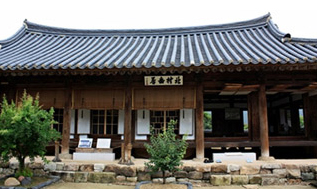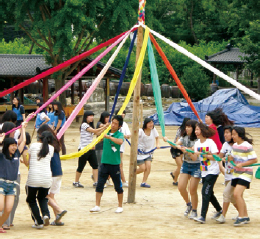Where to Experience Korean Traditional Culture
Hanok Village at Namsan-gol | hanokmaeul.seoul.go.kr
Namsan-gol is a place in which hanok (Korean traditional houses) have been restored and people can appreciate their beauty. Classes in intangible cultural assets include brush painting of sagunja (the Four Gentlemen: Japanese apricot, orchid, chrysanthemum and bamboo), etiquette, the tea ceremony and traditional handicrafts.
Yongin Korean Folk Village | www.koreanfolk.co.kr
This village has reconstructed many facets of late Joseon Kingdom (1392-1910) life so tourists can see them all in one setting. Farm houses, houses for ordinary people, district offices, lecture halls, Oriental medicine clinics, blacksmith’s People covered through their workplace forges, markets and even a nobleman’s house with 99 rooms have all been built to show the characteristics of different regions.
Andong Hahoe Folk Village | www.hahoe.or.kr
This village has reconstructed many facets of late Joseon Kingdom (1392-1910) life so tourists can see them all in one setting. Farm houses, houses for ordinary people, district offices, lecture halls, Oriental medicine clinics, blacksmith’s People covered through their workplace forges, markets and even a nobleman’s house with 99 rooms have all been built to show the characteristics of different regions.
Nagan Folk Village | www.nagan.or.kr
This village is famous as the setting for the drama Daejanggeum (Jewel in the Palace). Local residents currently live in thatched-roof houses. There are several opportunities to experience culture firsthand, such as making thatched handicrafts or weaving, and visiting a blacksmith’s forge and the lecture hall.
Yangdong Folk Village | yangdong.invil.org
This village is where tourists can see the Confucian culture of the Gyeongju region during the Joseon Kingdom (1392-1910). One hundred and fifty old traditional houses and 15 pavilions, monument pavilions and ganghakdang (lecture halls) have been preserved or recreated.
Institute of Korean Traditional Food | www.kfr.or.kr
This institute is intended to carry on the heritage of traditional Korean food. Korean and foreign visitors can taste a variety of traditional Korean foods here and attend cooking classes.
The School of Korean Traditional Culture | www.woorii.co.kr
Children can play folk games, learn traditional music and take part in other activities.
Korea Traditional Culture Center | www.koreaculture.or.kr
Visitors can learn about traditional food culture and the tea ceremony, try on traditional clothing and experience samulnori (percussion music derived from traditional Korean music and played by a quartet).



